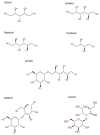Suitability of sugar alcohols as antidiabetic supplements: A review
- PMID: 35696228
- PMCID: PMC9261844
- DOI: 10.38212/2224-6614.3107
Suitability of sugar alcohols as antidiabetic supplements: A review
Abstract
The major goals in the management of diabetes are to maintain optimum control of high blood glucose level or hyperglycemia. Dietary modification is one of the most recommended treatment modalities for diabetic patients. The use of foods sweetened with sugar alcohols (also known as polyols) such as xylitol, sorbitol, mannitol, maltitol, lactitol, isomalt and erythritol has brought an escalating interest in the recent years since some sugar alcohols do not rise plasma glucose, as they are partially digested and metabolised. Diet composition and adequacy may be altered by replacing carbohydrates with sugar alcohols. It has been established that these polyols are appropriate sugar substitutes for a healthy lifestyle and diabetic foods. The present review focuses on the evidence supporting the use of sugar alcohols in the management of diabetes, by evaluating their physical and chemical properties, metabolism, absorption, glycemic and insulinemic responses. Although documentation on the glycaemic and insulinemic response of polyols is evident that these compounds have beneficial effects on the better management of hyperglycemia, the possible side effects associated with their normal or higher dosages warned their use according to the relevant Food & Drug Administration guidelines. For the same reason, future studies should also focus on the possible toxicity and side effects associated with the consumption of sugar alcohols in order to define their safety.
Conflict of interest statement
The authors declare no conflict of interests.
Figures
References
-
- International Diabetes Federation. IDF diabetes atlas. 9th ed. Brussels, Belgium: 2019.
-
- Erickson S, Carr J. The technological challenges of reducing the sugar content of foods. Br Nutr Found Nutr Bull. 2020;45:309–14. doi: 10.1111/nbu.12454. - DOI
-
- International Diabetes Federation. IDF framework for action on sugar. Brussels, Belgium: 2014.
Publication types
MeSH terms
Substances
LinkOut - more resources
Full Text Sources
Medical

